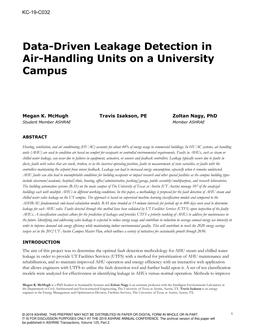Click here to purchase
Heating, ventilation, and air conditioning (HVAC) accounts for about 44% of energy usage in commercial buildings. In HVAC systems, air handlingunits (AHU) are used to condition air based on comfort for occupants or controlled environmental requirements. Faults in AHUs, such as steam orchilled water leakage, can occur due to failures in equipment, actuators, or sensors and feedback controllers. Leakage typically occurs due to faults inducts, faults with valves that are stuck, broken, or in the incorrect operating position, faults in measurements of state variables, or faults with thecontrollers maintaining the setpoint from sensor feedback. Leakage can lead to increased energy consumption, especially when it remains undetected.AHU faults can also lead to uncomfortable conditions for building occupants or impact research and other special facilities as the campus building typesinclude classroom/academic, hospital/clinic, housing, office/administrative, parking/garage, public assembly/multipurpose, and research laboratories.The building automation systems (BAS) on the main campus of The University of Texas at Austin (UT Austin) manage 107 of the analyzedbuildings each with multiple AHUs in different working conditions. In this paper, a methodology is proposed for the fault detection of AHU steam andchilled water valve leakage on the UT campus. The approach is based on supervised machine learning classification models and compared to theASHRAE fundamentals rule-based calculation models. BAS data trended at 15-minute intervals for periods up to 400 days were used to determineleakage for each AHU valve. Faults detected through this method have been validated by UT Facilities Services (UTFS) upon inspection of the faultyAHUs. A classification analysis allows for the prediction of leakages and provides UTFS a priority ranking of AHUs to address for maintenance inthe future. Identifying and addressing valve leakage is expected to reduce energy usage and contribute to reduction in average annual energy use intensity inorder to improve demand side energy efficiency while maintaining indoor environmental quality. This will contribute to reach the 2020 energy savingstargets set in the 2012 UT Austin Campus Master Plan, which outlines a variety of initiatives for sustainable growth through 2030.
Citation: 2019 Annual Conference, Kansas City, MO, Conference Papers
Product Details
- Published:
- 2019
- Number of Pages:
- 8
- Units of Measure:
- Dual
- File Size:
- 1 file , 1.4 MB
- Product Code(s):
- D-KC-19-C032
